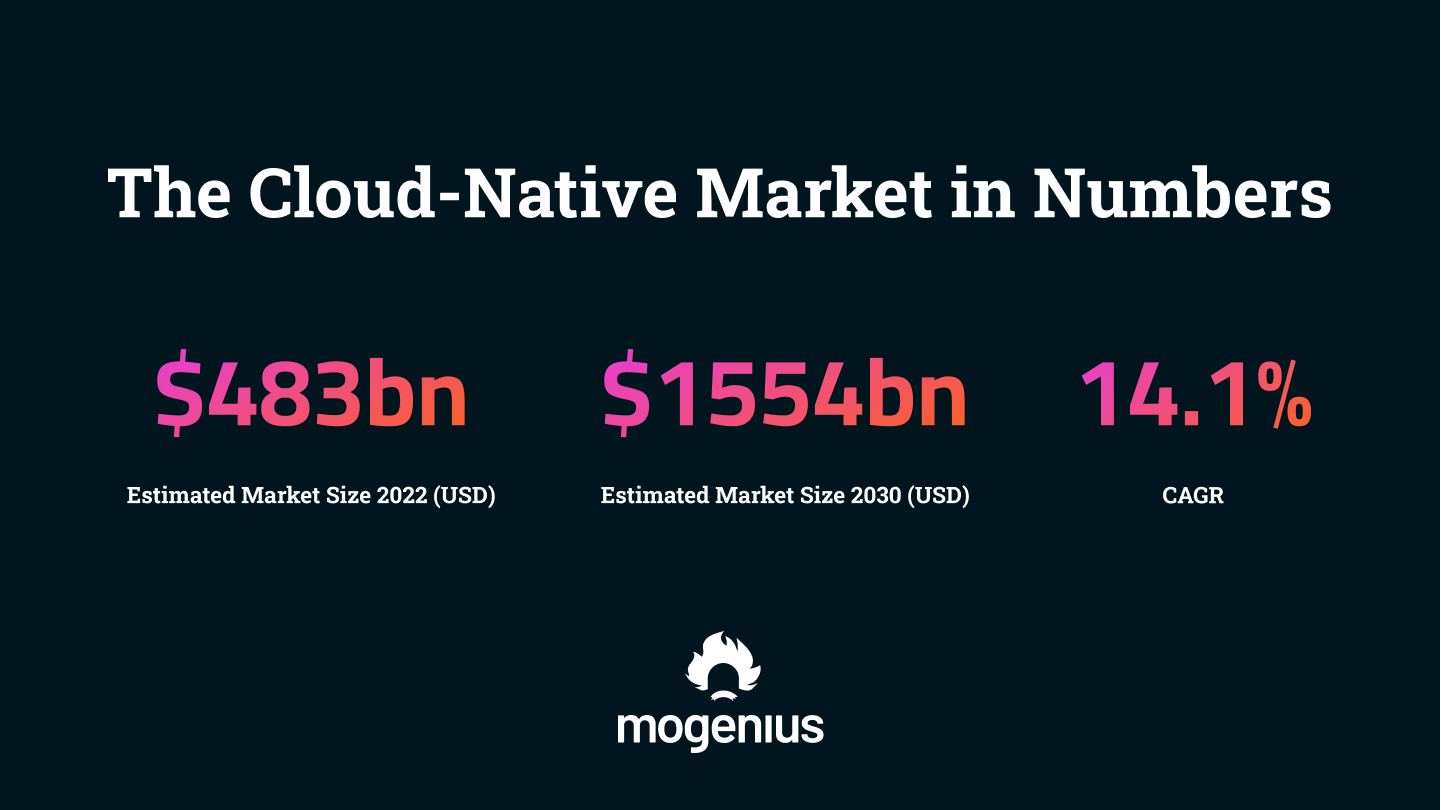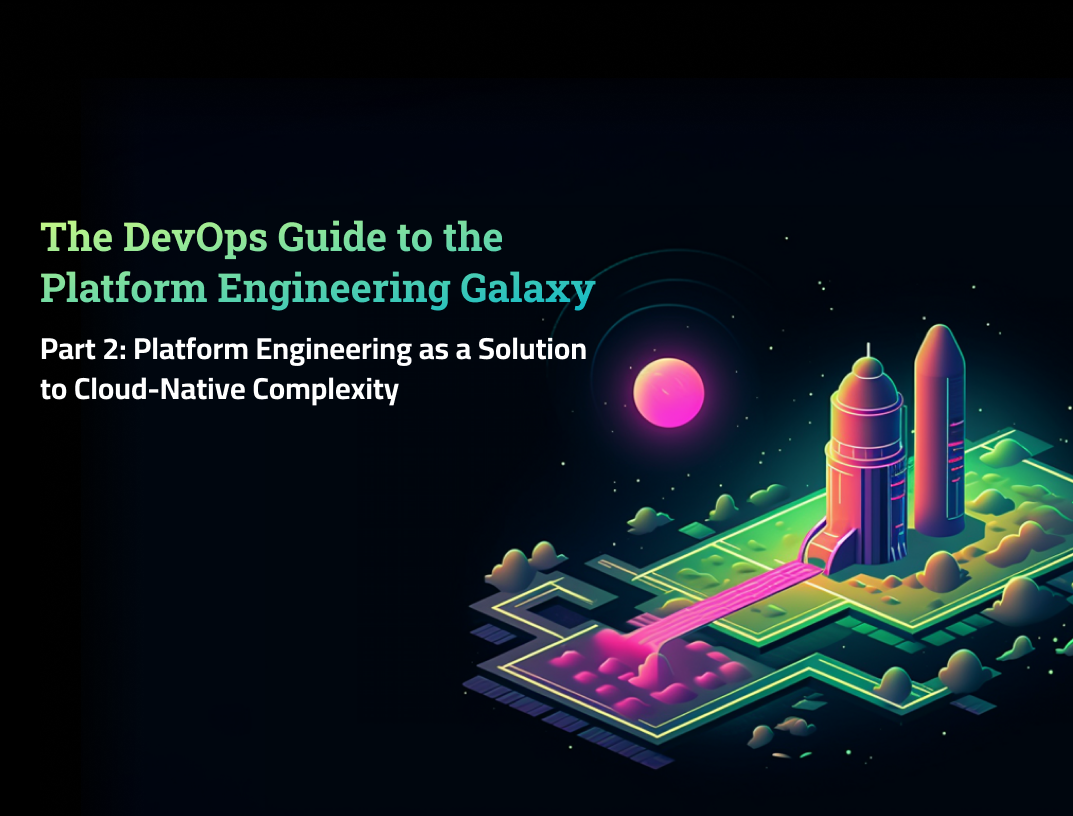
The State of Cloud-Native Software Development

Since its inception in 2015, cloud-native application development has rapidly gained momentum. It is becoming the de-facto status quo for modern application development due to its ability to provide improved scalability, productivity, and much more.
In this first article of the series, we'll examine the current state of cloud-native software development, focusing on the following key aspects:
- Global market trends for cloud-native adoption
- Trends and challenges of adopting cloud-native principles
- The emergence of platform engineering as an answer to the complexity of cloud-native software development
Adoption of Cloud-Native Principles
Gartner expects that more than 70% of global organizations will have adopted some form of cloud-native architecture by the end of 2023 to expedite their digitalization efforts. This is a big bump from just 20% in 2019.
So what are these organizations hoping to achieve by adopting cloud-native principles? Let’s take a quick look at the benefits of cloud-native architectures.
The Benefits of Cloud-Native Architecture
Since cloud-native application areas and benefits span a wide and varied range of topics, we’ll focus on the eight top-level benefits and how they are achieved in practice.
Scalability
- Goal: Achieve a balance of resources to fluctuating demand.
- Cloud-Native Contribution: Kubernetes and containers enable seamless auto-scaling and high availability.
Speed & Agility
- Goal: Boost delivery speed and market responsiveness.
- Cloud-Native Contribution: Microservices, CI/CD, and DevOps help accelerate development, testing, and deployment processes.
Resilience
- Goal: Improve system reliability and fault tolerance.
- Cloud-Native Contribution: The independent microservices architecture minimizes the impact of failures, avoiding system-wide crashes.
Cost-Effectiveness
- Goal: Minimize CAPEX and standardize OPEX.
- Cloud-Native Contribution: With no hardware dependencies, you can scale as needed and optimize resource usage to save costs.
Innovation
- Goal: Embrace cutting-edge technology.
- Cloud-Native Contribution: Leverage cloud innovations such as AI, ML, serverless computing, and more.
Global Reach
- Goal: Enhance the global customer experience.
- Cloud-Native Contribution: Utilizing global data centers to deploy closer to users reduces latency and improves performance.
Resource Optimization
- Goal: Maximize resource efficiency.
- Cloud-Native Contribution: Pay for what you consume, as auto-scaling minimizes wastage and optimizes utilization.
Continuous Improvement
- Goal: Enhance product quality through iterative development.
- Cloud-Native Contribution: DevOps and CI/CD enable continuous feedback, rapid bug fixes, and frequent updates.
Trends Driving the Adoption of Cloud-Native Principles
A few key catalysts are turbocharging the uptake of cloud-native principles. Rising comfort levels with Kubernetes, maturing subcategories, and the surfacing of new tech synergistic with cloud-native development fuel this shift. When looking at the market growth expectations for cloud-native, it is clear that adoption is ramping up.

Microservices & Containerization
Per a solo.io survey, 85% of orgs are making microservices their go-to architecture.
Containerization, another hot trend, is also climbing with the microservices and cloud-native wave. Grand View Research predicts the global container tech market to hit $8.2bn by 2025, expanding at a whopping 26.5% CAGR from 2019 to 2025.
Emerging Tech Boom
The surge in new tech adoption - AI, ML, 5G - is a significant tailwind for cloud-native. These techs thrive in the cloud.
Major cloud vendors like AWS are doubling down on their service offerings for ML and AI apps.
IaaS Maturity
More mature IaaS solutions simplify infrastructure management for orgs, making their cloud-native journey less bumpy while driving down costs.
SMEs - Cloud-Bound
SMEs are set to be the fastest-growing cloud segment from 2023 to 2030. Familiarity with cloud-native tech like Kubernetes, an expanding cloud-native toolkit, and affordable cloud resources make cloud-native architecture more attainable for smaller engineering teams.
The Challenges of Adopting Cloud-Native Principles
Cloud-native isn't just a passing trend; for many orgs, it's still new territory filled with stumbling blocks.
The Main Challenges of Cloud-Native Adoption for Organizations and Developers

Going cloud-native offers plenty of perks, but it also comes with its fair share of snags due to its inherent complexity.
These snags span from top-tier strategic and cultural pains to the nitty-gritty practical issues devs and end-users bump into daily.
Let’s break down the prime challenges orgs and end users (developers) face in their cloud-native journey.
Infrastructure Complexity: Managing distributed systems across multi-cloud environments is a tough gig with a steep learning curve. For developers, there's no getting around the need to level up on cloud-native tools and tech, including containers, microservices, and serverless.
FinOps: Cloud-native isn't a budgetary free ride. Orgs need to be aware of the lurking costs - egress fees, load balancing, and storage costs. Devs have to embrace the dark arts of cloud pricing, forecasting usage, estimating costs, and picking the right services.
Security: Multi-cloud security is no walk in the park. Misconfigurations? Breach Central. Devs, need to roll up their sleeves and become firm on encryption, auth, network security, and mastering the shared responsibility model.
Vendor Lock-in: Vendor reliance can leave a mark. Migration is no picnic and comes with a price tag. For devs, app portability is the name of the game, and a working knowledge of different cloud platforms is non-negotiable.
Performance Management: Ensuring apps perform well across regions, loads, devices – that's on the orgs. It calls for effective testing and monitoring. Devs, you're building for scale and resilience. Load balancing, caching, and their ilk are your new best friends.
Cultural Shift: Orgs need to embrace the DevOps mindset. Collaboration is key, and culture change isn't a sprint, it's a marathon. DevOps culture is the new normal for devs. The name of the game is continuous learning, communication, and collaboration.
Governance and Compliance: Compliance in a distributed system with global regulations is a headache waiting to happen. GDPR, CCPA – you name it. Devs need to be aware of and navigate the regulatory landscape. Ensuring data privacy, securing customer data, and conforming to regulations are high on the priority list.
The Impact on Developer Experience
One common pain point orgs often bump into while going cloud-native is the toll it takes on the developer experience (DevEx).
DevEx is essentially the workflow efficiency and satisfaction a dev derives from a set of tools, processes, and the overall ecosystem. It's about making a developer's life easier, minimizing friction, and maximizing productivity in their day-to-day coding activities.
Keeping a smooth DevEx is vital to keeping dev cognitive load in check and steering clear of frustration peaks as devs wrestle with daily tasks. A rocky DevEx slows down dev speed and makes talent attraction and retention a struggle.
Let's dive deeper into how cloud-native adoption shakes up DevEx by first understanding the key factors that shape it.
The 7 Pillars of a Good Developer Experience
Tool Usability: Simplicity and intuitiveness of tools in the stack. This includes quality docs and user-friendly interfaces.
Performance: How well the tech stack handles the required tasks. Laggy or unreliable tools = DevEx down.
Support/Resources: Availability and caliber of learning resources and support (both internal and external).
Integration: Seamless interplay between tools and developer's systems/workflows.
Feedback Loops: Efficiency of code-test-deploy cycle.
Debugging: Ease of spotting and squashing bugs during dev and testing.
Tooling Consistency: Minimize tech sprawl, keep a lean toolchain to reduce cognitive load.
Now that we have a general sense of what DevEx is and what contributes or detracts from it let’s take a closer look at what parts of cloud-native adoption can negatively impact it.
Issue 1: Navigating Complexity
Cloud-native tech isn't for the faint-hearted. It brings with it the burden of deploying and handling microservices, serverless infrastructures, containers, and orchestration tools. The complexity is a gear shift upward, demanding advanced skills and exacerbating cognitive load. The mantra of "you build it, you run it" can become daunting, especially for less experienced team members.
Issue 2: Avoiding Fragmentation in Tooling
In the cloud-native realm, there's no shortage of tools, but this variety can lead to a patchwork of solutions that disrupts the smoothness of your development environment. Beware of the "shiny object syndrome"—the allure of the latest tools and their supposed benefits can lead you down a confusing and frustrating path.
Issue 3: Managing the Learning Curve
The world of cloud-native demands learning new languages, paradigms, and frameworks. This consumes time and heightens cognitive load, affecting the speed at which your new or inexperienced developers can get up to speed and become productive.
Issue 4: Balancing Operational Responsibilities
Particularly in smaller teams with leaner DevOps support and less automation, developers may find themselves wearing the hat of an infrastructure manager. Navigating the complexities of cloud infrastructure can absorb up to 50% of a developer's time or heavily depend on DevOps, distracting them from their core responsibilities.
Issue 5: Addressing Increased Dependencies
Microservices architecture in a cloud-native setup introduces a network of dependencies, leading to an increased load in troubleshooting. It's a hidden cost that can disrupt productivity.
Issue 6: Keeping Up with the Tech Landscape
The cloud-native world is dynamic and ever-evolving. While it's exciting to witness the constant innovation, staying abreast with the ceaseless influx of new tech and best practices can become overwhelming. The landscape may stabilize as the technology matures, but the challenge of keeping up-to-date remains.
The Emergence of Platform Engineering as a Solution to Cloud-Native Complexity

Platform Engineering is rapidly emerging as a potent antidote to the complexity induced by cloud-native environments. CTOs grapple with the double-edged sword of cloud-native: while it offers scalability and flexibility, it also burdens developers with additional cognitive load, degrades their experience, and generates a wave of low-level DevOps tasks that can stall productivity.
Platform Engineering is the discipline focused on building and managing shared, self-service tech platforms that abstract away infrastructural complexities. This empowers developers to autonomously handle tasks like environment setup, testing, and deployment, enhancing productivity. It acts as a bridge between DevOps and software engineers, encapsulating best practices and streamlining workflows, reducing cognitive load on developers.
Platform Engineering abstracts much of the infrastructural complexity that developers face. This team provides a curated and simplified developer experience, automating repetitive tasks and handling underlying infrastructure so developers can focus on what they do best - writing code that delivers value to the business.
Platform engineers alleviate the cognitive load on developers by encapsulating best practices, maintaining toolchain consistency, and streamlining workflows, improving their productivity and morale.
Furthermore, Platform Engineering can significantly reduce DevOps load by automating and standardizing infrastructure management. By building shared platforms, we reduce the number of bespoke environments and systems, simplifying maintenance and reducing the likelihood of error-induced firefighting.
In essence, Platform Engineering is a necessary evolution for technical teams to tackle the challenges of the cloud-native future. Engineering leaders must prioritize its adoption to ensure developers can deliver value efficiently without being bogged down by the inherent complexity of modern tech stacks.

Up Next: Deep Dive Into Platform Engineering as a Solution to Cloud-Native Complexity
We recommend to keep reading our new blog series, “The DevOps Guide to the Platform Engineering Galaxy,” if you’re a CTO or engineering leader struggling with poor DevEx and cloud-native complexity. The series aims to explain and demystify Platform Engineering while providing actionable insights on when and how to adopt this new discipline.
The next article is about "Platform Engineering as a Solution to Cloud-Native-Complexity".
FAQ
Interesting Reads
The latest on DevOps and Platform
Engineering trends
Subscribe to our newsletter and stay on top of the latest developments


